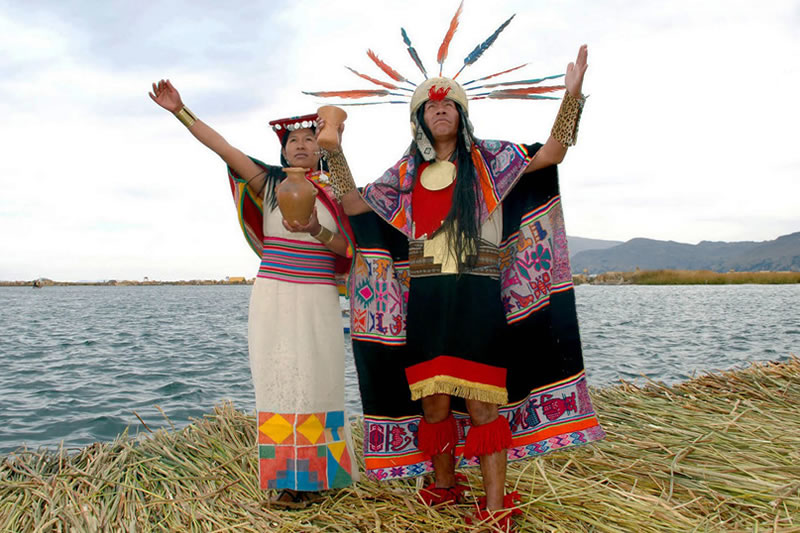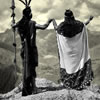Legends of the origin of the Inca Empire
Like the great civilizations of the world (Egypt, Greece, China, Rome, Mesopotamia, etc.); the Incas explained their origins with myths and legends. It is known that there are 2 legends about the origin of the Incas: The legend of Manco Cápac and Mama Ocllo and the Legend of the Ayar brothers. The legend of the Ayar brothers was collected by many chroniclers such as: Guamán Poma, Cieza de León and Betanzos. The legend of Manco Cápac and Mama Ocllo was collected by the Cusco chronicler Garcilaso de la Vega. Learn more!
- Inca Legend – The Ayar brothers
- Inca Legend – Manco Cápac and Mama Ocllo
- Historical sources on the origin of the Incas
- Inca myth of the creation of the world
- The myth of the Inkarri
- More information about the empire of the Incas

Staging of the Inca Legend of Manco Capac and Mama Ocllo
Inca Legend – The Ayar brothers
- Legend has it that the god of the Andean world ‘Huiracocha’ sent his 4 children to look for fertile lands.
- From the cave Pacaritambo came the 4 Ayar brothers with their women: Ayar Cachi and Mama Huaco, Ayar Uchu and Mama Ipacura, Ayar Auca and Mama Rahua and, finally, Ayar Manco and Mama Ocllo.
- The brothers together with 10 ayllus (families) went southeast.
- Ayar Cachi was a strong and brave man who caused the envy of his brothers who decided to kill him.
- Ayar Cachi was persuaded to return to the caves of Pacarina. When he returned to the cave, they closed it by placing a stone in the entrance.
- The other brothers continued their way to the hill ‘Huanacauri’ where they found a stone idol.
- Full of respect and fear, the brothers entered. Then Ayar Uchu jumped into the back of the statue and froze.
- After continuing the trip, in the Pampa del Sol, Ayar Uchu then jumped to the back of the statue and was petrified.
- Finally, Ayar Manco, accompanied by the 4 women, arrived in Cusco where he sank his rod as a sign of fertile land.
- Excited to arrive in Cusco, they decided to found a city in honor of the god Huiracocha and the Sun god. The city would be the capital of the Inca Empire.
Inca Legend – Manco Cápac and Mama Ocllo
- The sun god, seeing the sadness in which the men of the earth were sunk, sent a couple: Manco Cápac and his wife (and sister) Mama Ocllo..
- The sun god gave them a golden scepter and ordered them to civilize the world and found an empire that worshiped the sun.
- So it was that Manco Cápac and Mama Ocllo emerged from the waters of Lake Titicaca. They were warned that the place where the golden scepter would sink would be the propitious place to found an empire.
- Manco Cápac went north. Mama Ocllo, south of the valley. They both summoned and subjected the people on their journey who considered them divine beings.
- After much travel, the scepter sank in the hill Huanacauri. In that place Manco Cápac and Mama Ocllo started the origin of the Incas.
- Manco Cápac taught men how to grow corn, wheat and build houses. Mama Ocllo taught women to spin and weave to make wool and cotton dresses.
Historical sources on the origin of the Incas
- According to historical findings, it is presumed that the Incas came from the Tiahuanaco culture in the Altiplano of Peru.
- This human group had to emigrate from their lands due to the sudden invasion by the Aymara culture.
- Thus, the human group headed north led by Manco Cápac. They spent time in different places like ‘Huanacancha’ and ‘Pallata’.
- Finally, Manco Cápac ordered the invasion of the small towns that lay in Cusco. He also got alliances through marriages. Over the years, this human group was renamed ‘Inca’.
Inca myth of the creation of the world
- The Andean god Viracocha decided to give rise to a world in darkness where giants lived.
- The giants disobeyed Viracocha who decided to disappear his creation causing a torrential rain.
- Then Viracocha created man in his likeness. In addition, he created the moon, the sun and the stars so that men could appreciate his creation through light.
- Viracocha sent the world to Viracochan, his son who taught men to live in harmony, to cultivate the land, to harvest and to govern themselves with wisdom.
- Some men disobeyed Viracochan and that’s why they turned them into stone. Then he went to a fertile valley he called Cusco. There I create a person called Alcaviza.
- “After Alcaviza, the Incas orejones will arrive. My wish is that they be respected, “said Viraconchan at the time of creating Cusco.
The myth of the Inkarri
- The myth of Inkarri was initially compiled in 1955 by the researcher Óscar Núñez del Prado in an anthropological incursion into the Q’eros community, considered the last descendants of Cusco.
- Since then, various researchers have managed to collect up to fifteen different versions of the same myth throughout the entire Peruvian Andean territory, and even in Asháninka villages in the jungle part of the country.
- It is therefore concluded that this myth survived to the present day by oral means from the 18th century and even before.
- This myth, in general, tells that Inkarri is the god of the Andean world. His name means ‘Inka king’.
- At one point in history, Inkarri was deceived as a prisoner of ‘Españarri’, a name that means ‘King Spain’.
- Españarri tortured and murdered Inkarri. As a sign of his power, he cut off his limbs and hid them in the four regions or ‘his’ that formed the Tahuantinsuyo (empire of the Incas). His head was buried in the city of Cusco.
- The Inkarri myth tells that this head is still alive in the city of Cusco. Slowly Inkarri’s limbs will regenerate and rejoin. When this finally happens, Inkarri will defeat ‘Españarri’ and return to restore the Tahuantinsuyo.
- This myth has various probable historical origins such as: the capture of Atahualpa in Cajamarca and the beheading of Túpac Amaru II.
More information about the Inca empire
- It is estimated that Manco Cápac was an Inca ruler for about 40 years. He was the one who established the laws of conduct and basic teachings.
- The Incas began their existence in the 12th century with the leadership of Manco Cápac. It is considered the end of the Inca Empire in the mid-sixteenth century with the capture of the Inca Atahualpa by the Spanish invaders.
- The Inca Empire achieved its maximum expansion during the government of the Inca Pachacutec (1438 – 1471). It encompassed part of the current territories of Colombia, Ecuador, Chile, Bolivia, Argentina and all of Peru.
- Pachacutec is also recognized as the Inca that built Machu Picchu.
- As proof of its existence, to this day many Inca cities survive, such as Pisac, Ollantaytambo, Choquequirao and, of course, Machu Picchu.
By Ticket Machu Picchu – Last updated, February 14, 2022
